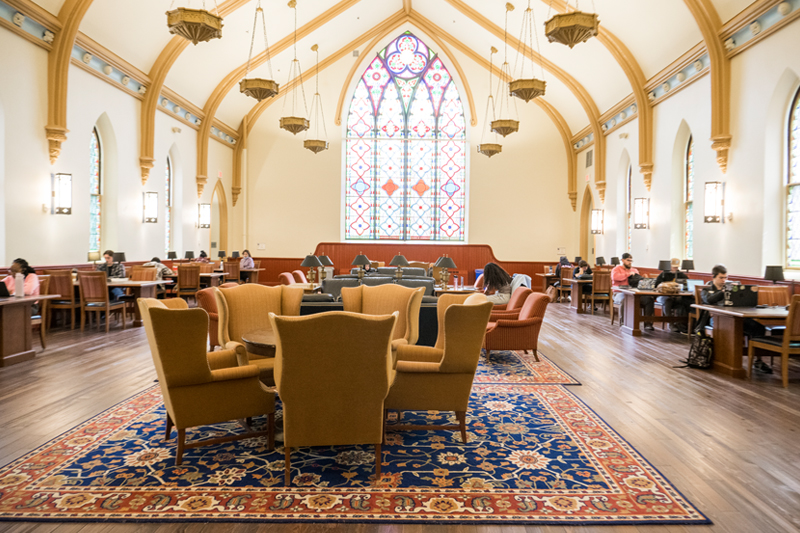


The history of Daugherty Hall
Photos by Kathy F. Atkinson and courtesy of University Archives October 11, 2023
Favorite study spot on campus has a storied past as church, dining hall, student center and rathskeller
Few buildings can claim to have been both a church and a bar.
Formerly the First Presbyterian Church of Newark, Daugherty Hall, the Victorian gothic revival study lounge attached to the University of Delaware’s Trabant University Center, has certainly had a storied past — as a church, student center, study lounge, food court and even rathskeller.
Perhaps a hidden gem on campus, Daugherty Hall is now used as a tranquil study and gathering space with dramatic arched stained glass windows reminiscent of its origin.
The church land was purchased by the congregation in 1866. The building, which took several years to construct, is built of blue granite and native brown stone and features high-arched windows in the high Victorian gothic revival style. Originally, the building had a 100-foot steeple, which was removed.

The 150-year-old building, which is listed on the National Register of Historic Places, has had many names throughout its history, including the Old Stone Church, the Gray Stone Building and the Gray Stone Church. It was renamed in honor of John Fenton Daugherty, physics professor and the first dean of men at UD, when the school acquired the property in 1967 from the trustees of the First Presbyterian Church.
Daugherty Hall opened as the University’s second student center space. (Perkins Student Center, at the time, was simply called “the student center.”) Briefly shuttered in the mid 1970s to cut University operating costs, Daugherty Hall reopened as a student and commuter center with programming space, a modest food court and study spaces.
By the time Daugherty’s second dining facility, The Abbey, opened in the late 1980s, the student population had quickly outgrown the space, and Trabant University Center, which included a larger food court, was built around the building in 1996. Only the original portion of the First Presbyterian Church remains today. Despite some opposition, a 1920s addition to the church was demolished when Trabant was built.
“I think it's a really interesting use of how they ended up attaching it to Trabant,” said Lisa Gensel, coordinator of archives at UD. “Keeping aside should they have kept the whole thing or not, I think it's an interesting visual juxtaposition. It maintains some part of the streetscape history while also expanding what the University needed at that time.”
The space was most recently renovated in 2015, with improvements including reading tables with lamps that contain mobile device charging outlets, more ambient lighting and additional comfortable furniture options for students relaxing in the space.

Indeed, it’s the cozy feel of the building that students love.
“I like the aesthetic of Daugherty,” said Tess Donatello, a junior international relations and history major. “It’s really quiet and calm, and it’s really pretty. It’s different from other study spots. It has kind of a warmer, cozier feel.”
Eden Groum, a senior honors neuroscience major, also loves studying in Daugherty because there’s usually a spot open — if not a table, then a comfy couch or chair — and it’s quiet.
“Personally, I need it to be completely silent when I’m reading or writing, and this room is pretty isolated and there’s not a lot of distraction,” she said. “Everyone here is focused on what they need to do, and that drives me to do the same thing.”
About John Fenton Daugherty
John Fenton Daugherty’s career at the University of Delaware spanned 37 years. He joined the UD faculty in 1929 as an associate professor of physics, became a professor and chairman of the department the next year, and served as the first dean of men of the University from 1944 to 1952.
Possibly the most noted event of his career as a dean was a firecracker incident in 1951, which involved students setting off firecrackers for several months in Harter Hall. Daugherty issued an ultimatum to students — either the culprits would come forward or the dormitory would be evacuated. When no one confessed, Daugherty had the 104 residents evicted. As the last student left, a final blast of firecrackers went off and a sign was displayed saying “Fireworks Show Cancelled.” In a compromise solution, the dormitory council agreed to be responsible for keeping order, and most of the students returned. The event received national coverage with an item on the front page of The New York Times and a double spread in Life magazine.

Contact Us
Have a UDaily story idea?
Contact us at ocm@udel.edu
Members of the press
Contact us at 302-831-NEWS or visit the Media Relations website

